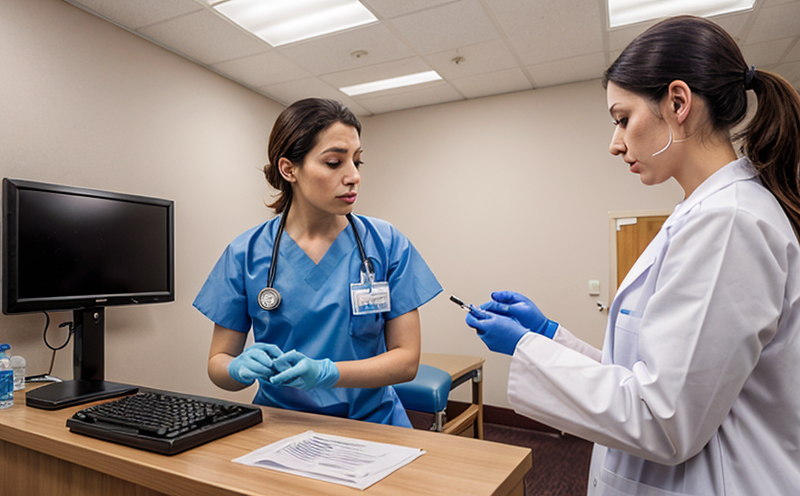Antifungal Drug Residue Testing in Veterinary Feed
The use of antifungal drugs in veterinary feed is regulated to ensure animal health and safety. Regulatory bodies such as the U.S. FDA, European Commission, and others have established limits for antifungal drug residues in feed to prevent adverse effects on animals, including organ toxicity, immune suppression, and reduced efficacy of other medications.
Our Antifungal Drug Residue Testing service is designed specifically for the veterinary feed industry. We provide comprehensive testing solutions that help ensure compliance with international standards like ISO 17025 and FDA regulations. Our laboratory adheres to strict quality control measures to deliver accurate, reliable results every time.
Testing involves several steps: sample collection, preparation, analysis using advanced spectroscopic techniques such as Liquid Chromatography-Mass Spectrometry (LC-MS/MS), and interpretation of results against regulatory limits. This process ensures that even trace amounts of antifungal drugs are detected accurately.
The importance of this testing cannot be overstated. It helps protect public health by preventing the development of drug-resistant fungi and ensuring that animals receive safe food products free from harmful contaminants. Our expertise in this field means we can offer tailored services to meet specific client needs, whether it’s routine testing or one-off assessments.
In addition to detecting residues, our service also provides valuable insights into potential sources of contamination within the feed production process. This information is crucial for improving quality control measures and preventing future issues. By working closely with clients throughout the testing process, we ensure that all aspects are fully understood and addressed.
- Sample Collection: Proper sampling techniques are critical to ensuring accurate results. We recommend collecting samples from various points in the feed production line to capture a representative sample.
- Spectroscopic Analysis: Using LC-MS/MS, we can detect even extremely low levels of antifungal drugs. This level of precision is essential for meeting stringent regulatory requirements.
- Data Interpretation: Our experienced analysts interpret the data according to relevant standards and guidelines, providing clients with clear recommendations on next steps.
With our Antifungal Drug Residue Testing service, you can rest assured that your veterinary feed products meet all necessary regulatory requirements. By partnering with us, you gain access to state-of-the-art facilities, skilled professionals, and robust quality assurance processes—all aimed at delivering the highest standards of care.
Scope and Methodology
The scope of our Antifungal Drug Residue Testing service includes not only the detection of antifungal drugs but also an assessment of their impact on animal health. We employ a multi-faceted approach to ensure comprehensive coverage:
- Detection Limits: Our testing can detect residues down to parts per billion levels, ensuring no trace is missed.
- Spectral Analysis: Utilizing LC-MS/MS technology allows us to identify both known and unknown compounds with high accuracy.
- Regulatory Compliance: Results are reported against relevant international standards like ISO 17025, ensuring compliance with global regulations.
The methodology involves several key steps: sample collection from different stages of the feed production process; extraction and clean-up procedures; instrumental analysis using LC-MS/MS; and finally, interpretation of results by our team of experienced analysts. Each step is carefully designed to ensure reliability and accuracy of the findings.
Our approach ensures that every aspect of antifungal drug usage in veterinary feed is accounted for, providing clients with detailed reports on potential risks and mitigation strategies. This holistic view helps build trust between producers and consumers by demonstrating a commitment to safety and quality.
Quality and Reliability Assurance
Achieving accurate and reliable test results requires stringent quality assurance measures at every stage of the process. At our laboratory, we follow ISO 17025 standards for proficiency testing and internal validation to maintain high levels of accuracy and precision.
We employ rigorous calibration protocols and use only the most advanced instrumentation available on the market today. Our analysts undergo continuous training to stay abreast of industry developments and best practices. Regular audits and external assessments further reinforce our commitment to excellence in every test conducted.
The quality assurance process extends beyond internal controls; it also involves collaboration with clients throughout the testing cycle. We encourage open communication regarding expectations, timelines, and any concerns that may arise during the project. This collaborative approach ensures that all parties are aligned towards achieving common goals—safe, effective veterinary feed products.
By adhering to these strict protocols, we can confidently provide accurate results that stand up to scrutiny by regulatory authorities worldwide. Our aim is not only to meet but exceed expectations when it comes to ensuring the safety and efficacy of antifungal drug residues in veterinary feed.





